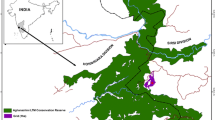Abstract
We examined demographic consequences of habitat fragmentation in the lion-tailed macaque in the Anamalai Hills in southern Western Ghats. The parameters examined were group size, age/sex composition, and birth rate, in relation to various habitat parameters. Demographic parameters were estimated for 11 groups in 8 rain forest fragments, during January to May 1996. Area, tree density, canopy cover, canopy height, and tree basal area were estimated for these fragments. As fragment area decreased, there was a decline in birth rate and proportion of immatures in the group, and an increase in the number of adult males, and the variability in group size and adult sex ratios. A similar pattern was also observed with decreasing values of other habitat variables. Differences in the founder population size and age structure, demographic randomness, and history of poaching have caused greater variability in group size and adult sex ratios in the small fragments. The lack of dispersal in the small fragments is another reason for the high variability.
Similar content being viewed by others
References
Ali, R.;Johnson, J. M.;Moore, J. 1985. Female emigration in Nilgiri langurPresbytis johnii: a life history strategy.J. Bombay Natl. Hist. Soc., 82: 249–252.
Arnold, G. W.;Steven, D. E.;Weeldenburg, J. R.;Smith, E. A. 1993. Influences of remnant size, spacing pattern and connectivity on population boundaries and demography inEuros macropus robustus living in a fragmented landscape.Biol. Conserv., 64: 219–230.
Decker, B. S. 1994. Effects of habitat disturbance on the behavioral ecology and demographics of the Tana River Red Colobus (Colobus badius rufomitratus).Int. J. Primatol., 15: 703–737.
Dittus, W. P. J. 1979. The evolution of behaviours regulating density and age-specific sex ratios in a primate population.Behaviour, 69: 265–302.
Downes, S. J.;Handasyde, K. A.;Elgar, M. 1997. The use of corridors by mammals in fragmented Australian eucalypt forests.Conserv. Biol., 11: 718–726.
Hanski, I.;Gilpin, M. E. 1991. Metapopulation dynamics: brief history and conceptual domain.Biol. J. Linn. Soc., 40: 3–16.
Holmes, J. E. 1996. Parasites as threats to biodiversity in shrinking ecosystems.Biodiversity Converv., 5: 975–983.
Johns, A. D.;Skorupa, J. P. 1987. Responses of rain-forest primates to habitat disturbance: a review.Int. J. Primatol., 8: 157–191.
Kumar, A. 1995a. The life history, ecology, distribution and conservation problems in the wild. In:The Lion-tailed Macaque: Population and Habitat Viability Assessment Workshop,Kumar,A.;Molur,S.;Walker,S. (eds.), Zoo Outreach Organization, Coimbatore, India, pp. 7–17.
Kumar, A. 1995b. Birth rate and survival in relation to group size in the lion-tailed macaque,Macaca silenus.Primates, 36: 1–9.
Kumar, A.; Kurup, G. U. 1993. The demography of the lion-tailed macaque in the wild. In:Proceedings of the IVth International Symposium on the Lion-tailed Macaque, 11–14 October 1994, Madras, pp. 1–10.
Laurance, W. F. 1994. Rainforest fragmentation and the structure of small mammal communities in tropical Queensland.Biol. Conserv., 69: 23–32.
Marsh, C. W.;Johns, A. D.;Ayres, M. 1987. The effect of habitat disturbance. In:Conservation of Primates in Tropical Rain Forest,Gartlan,J. S.;Marsh,C. W.;Mittermeier,R. A. (eds.), Alan Liss, New York, pp. 83–107.
Quinn, J. F.;Hastings, A. 1987. Extinction in sub-divided habitats.Conserv. Biol., 1: 198–208.
Struhsaker, T. T. 1976. A further decline in numbers of Amboseli vervet monkeys.Biotropica, 8: 211–214.
Sugiyama, Y.;Ohsawa, H. 1982. Population dynamics of Japanese macaques with special reference to the effect of artificial feeding.Folia Primatol., 39: 238–263.
Umapathy, G.; Kumar, A. in press. The occurrence of arboreal mammals in the rain forest fragments in the Anamalai Hills, south India.Biol. Conservation.
Wittenberger, J. F. 1980. Group size and polygyny in social mammals.Amer. Naturalist, 115: 197–221.
Author information
Authors and Affiliations
About this article
Cite this article
Umapathy, G., Kumar, A. The demography of the lion-tailed macaque (Macaca silenus) in rain forest fragments in the Anamalai Hills, South India. Primates 41, 119–126 (2000). https://doi.org/10.1007/BF02557793
Received:
Accepted:
Issue Date:
DOI: https://doi.org/10.1007/BF02557793




